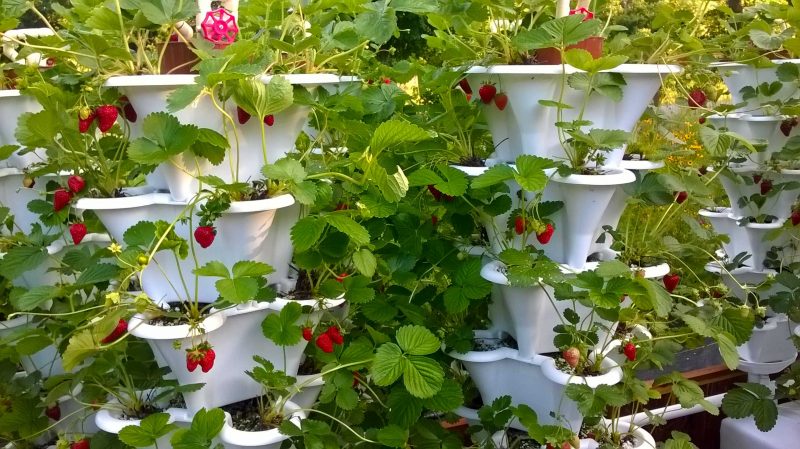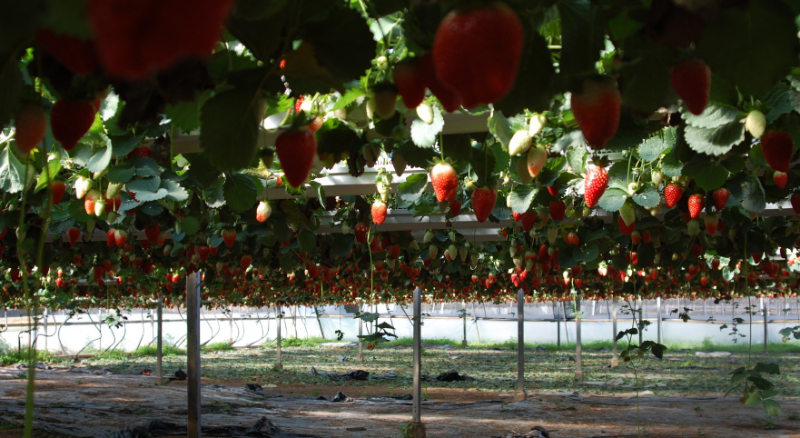Curly strawberries can be either a fruit plant on a personal plot or decorative. This fragrant berry requires some care, in response to which the gardener is pleased with a plentiful harvest.
Material Content:
Description of Varieties of Curly Strawberries
One of the most popular varieties of curly strawberries is Queen Elizabeth. It belongs to the repair and starts bearing fruit in June, and ends in October. From one bush per season, you can collect up to 2 kg of fairly large berries. This curly repairing strawberry is universal in use and well tolerates even long transportations.
The next favorite variety without exception is Alba. This strawberry is early ripe, and extremely resistant to May frost. With each bush, gardeners with competent cultivation collect up to one and a half kilos of berries.
Another variety common on our sites is called Ostara. The berry is bred in Holland. A variety resistant to frost, but prone to diseases of the root system. This ampel strawberry yields stably rich crops.
In addition to the most common varieties listed, our gardeners grow winding strawberries "Remontantnaya", "Geneva", "Moskovskaya", "Elan", "Kherson", "Chinese" and many other varieties.
Growing seedlings from seeds
Planting material of curly strawberries can be obtained independently. To do this, select some of the largest and earliest fruits, dry them, and then select the seeds. Already in the spring it will be possible to start sowing.
It is important to consider that curly varieties do not get along well with regular strawberries.Therefore, ampelous plants and bush plants are not grown nearby.
- Seeds are sown in shallow boxes filled with nutritious soil mixture.
- After sowing, the soil is moistened, and the drawers are tightened with a film to create a greenhouse effect.
- Containers should be placed in a bright and warm room, but not in the sun.
- When a pair of true leaves appear on seedlings, it should be peaked in separate pots.
Already in May, in the mid-climate climate, such seedlings can be planted in open ground.
Planting in open ground
All strawberry varieties, including curly ones, love loose, slightly acidic soil with high air and water permeability rates.
Suitable soil mixture for filling the planting pit consists of:
- 3 parts of turf;
- 1 parts of river sand;
- 6 parts of peat.
You can prepare the soil mixture from the following components:
- 1 part of garden land;
- 1 part humus;
- 1 part peat.
Experienced summer residents who have been growing strawberries in a vertical way for many years are advised to add ash to the prepared soil mixture. This helps to prevent the appearance of various fungal root diseases.
Rules for planting strawberries:
- The selected area is dug up on a bayonet.
- Dig holes in the size of the rhizomes of seedlings.
- Seedlings are placed in the hole so that the heart is slightly above the soil level.
- The roots of seedlings are covered with soil and slightly tamped.
- The earth is shed well.
- If the heart is much higher than the surface, add earth.
The day after planting, you need to inspect the strawberries. If the heart is buried in the ground, the bush should be raised. If, on the contrary, the strawberries are planted too high, you need to fill the ground.
Features of care and productivity
Growing curly strawberries is not as difficult as it might seem at first glance. Care for this crop comes down to cultivation, watering, weeding, top dressing and mulching of beds.
Since climbing varieties grow in a limited amount of land, it will be necessary to water the bushes more often. An exception to the rule is bushes that grow on pylons. Caring for such strawberries is traditional.
- After planting, the first week the bushes are watered three times a day. Adult specimens require watering three times a week. Under each bush, it is enough to pour about 200 ml of water. In extreme heat, the volume of water increases. After watering, the substrate should be loosened. Vertical beds are very convenient to equip with a drip irrigation system.
- Weeding is carried out the day after watering. Even if strawberries grow in containers or on vertical beds, weed seeds still get into them.
- To mulch or not the curly varieties of a berry berry is a moot point. On ordinary beds this is mandatory. But each summer resident decides for himself whether he will mulch strawberries in containers or pots. In any case, the mulch will never be superfluous, since it delays the evaporation of moisture and prevents the weed from germinating.
New technology is mulching curly strawberries with hydrogel, which greatly reduces the need for watering. This helps to avoid drying out of bushes to summer residents who come to their site only on weekends.
- Once a week, strawberries are fed. They begin to fertilize from the second week after planting. Liquid concentrates with humate or humus are suitable.
- Adult bushes can prematurely deplete if you do not trim the mustache on time. On one bush leave no more than 5 pieces. The rest should be ruthlessly cut out. The yield of curly strawberries directly depends on this, since the bushes spend a lot of effort on forcing out young outlets.
- Harvesting strawberry is harvested as it ripens throughout the season. Many varieties bear fruit up to frost.
Every four years, strawberries are transplanted. It is advisable to completely change the landing.
Preparing for the wintering of repair strawberries
Features of growing remontant curly strawberries in the fact that vertical beds for the winter will have to be brought into the room. If the gardener does not have such an opportunity, then the plantings are insulated before winter. You can just cover the bushes with earth and cover additionally with spruce branches or hay.
If the strawberry grows in a suspended position, then the flowerpot should be removed and dug in the ground, then the frame should be built and covered with warm material, such as burlap, and additionally wrapped around with spruce branches.
Diseases and Pests
Like any other open-ground plant, curly strawberries have their own pests and diseases. But on vertical beds, the berry is less susceptible to disease.
- A frequent visitor to strawberry plantations is a tick. Attacks of this parasite lead to a decrease in yield and wilting of bushes. You can get rid of the tick by treating plants with Fufanon. Spray strawberries every 7 days.
- Even strawberry plantations can attack nematodes, as a result of which the berries become small, tight. It will not be possible to get rid of this pest by chemical treatments - diseased bushes will have to be destroyed.
Read also:fufanon: application instruction
In order to avoid infection with various diseases, in the spring and autumn, beds for preventive purposes are treated with biological products against fungi. If strawberries still get sick with a fungal disease, then the bushes will have to be sprayed with fungicides.
Use such drugs strictly according to the instructions.
Most often, strawberries are affected by various rot due to improper care. By following the simple rules of agricultural technology of this culture, many problems can be avoided.
Curly strawberries are a very unusual plant, which can be increasingly seen on our garden plots. This culture can be grown even at room conditions and pick up juicy and fragrant berries all year round.


















